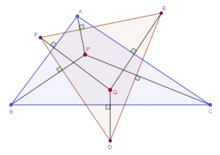
Two orthologic triangles
In geometry, two triangles are said to be orthologic if the perpendiculars from the vertices of one of them to the corresponding sides of the other are concurrent (i.e., they intersect at a single point). This is a symmetric property; that is, if the perpendiculars from the vertices A, B, C of triangle △ABC to the sides EF, FD, DE of triangle △DEF are concurrent then the perpendiculars from the vertices D, E, F of △DEF to the sides BC, CA, AB of △ABC are also concurrent. The points of concurrence are known as the orthology centres of the two triangles.[1][2]
Some pairs of orthologic triangles
The following are some triangles associated with the reference triangle ABC and orthologic with it.[3]
- Medial triangle
- Anticomplementary triangle
- Orthic triangle
- The triangle whose vertices are the points of contact of the incircle with the sides of ABC
- Tangential triangle
- The triangle whose vertices are the points of contacts of the excircles with the respective sides of triangle ABC
- The triangle formed by the bisectors of the external angles of triangle ABC
- The pedal triangle of any point P in the plane of triangle ABC
References
- ↑ Weisstein, Eric W. "Orthologic Triangles". MathWorld. MathWorld--A Wolfram Web Resource. Retrieved 17 December 2021.
- ↑ Gallatly, W. (1913). Modern Geometry of the Triangle (2 ed.). Hodgson, London. pp. 55–56. Retrieved 17 December 2021.
- ↑ Smarandache, Florentin and Ion Patrascu. "THE GEOMETRY OF THE ORTHOLOGICAL TRIANGLES". Retrieved 17 December 2021.
This article is issued from Wikipedia. The text is licensed under Creative Commons - Attribution - Sharealike. Additional terms may apply for the media files.